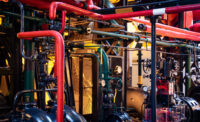As building owners and operators look for ways to safeguard occupants, some are closing air intakes to prevent the introduction of hazardous materials into ventilating systems. But according to professionals skilled in indoor environmental control, these well-intentioned actions could create extensive health problems.
“America’s buildings are amongst the safest in the world; constructed under the protection of a system of codes and standards to assure the utmost protection of safety, comfort and health,” said William J. Coad, P.E., ASHRAE president.
“Any steps taken that result in a reduction of outdoor air ventilation rates or a change in the manner of providing and treating the ventilation air could seriously change the engineered balance of the interior environment. Such changes can result in many of the manifestations of sick building syndrome causing such maladies as discomfort, eye, nose and throat irritation, headaches, fatigue, lethargy, loss of productivity, upper respiratory symptoms, skin irritation or other sickness.”
Americans spend 90% of their time indoors. Any deterioration of the indoor environment would create major health problems, the organization says.
ASHRAE and many other engineering organizations, including the U.S. Army Corps of Engineers, are reevaluating the safety aspects of buildings in light of the terrorist attacks of Sept. 11. Their findings will provide guidance to building operators and designers for the design and operation of buildings that will make them safer while not compromising environmental integrity. Included in their studies will be the prevention of hazardous material entry into ventilation systems.




